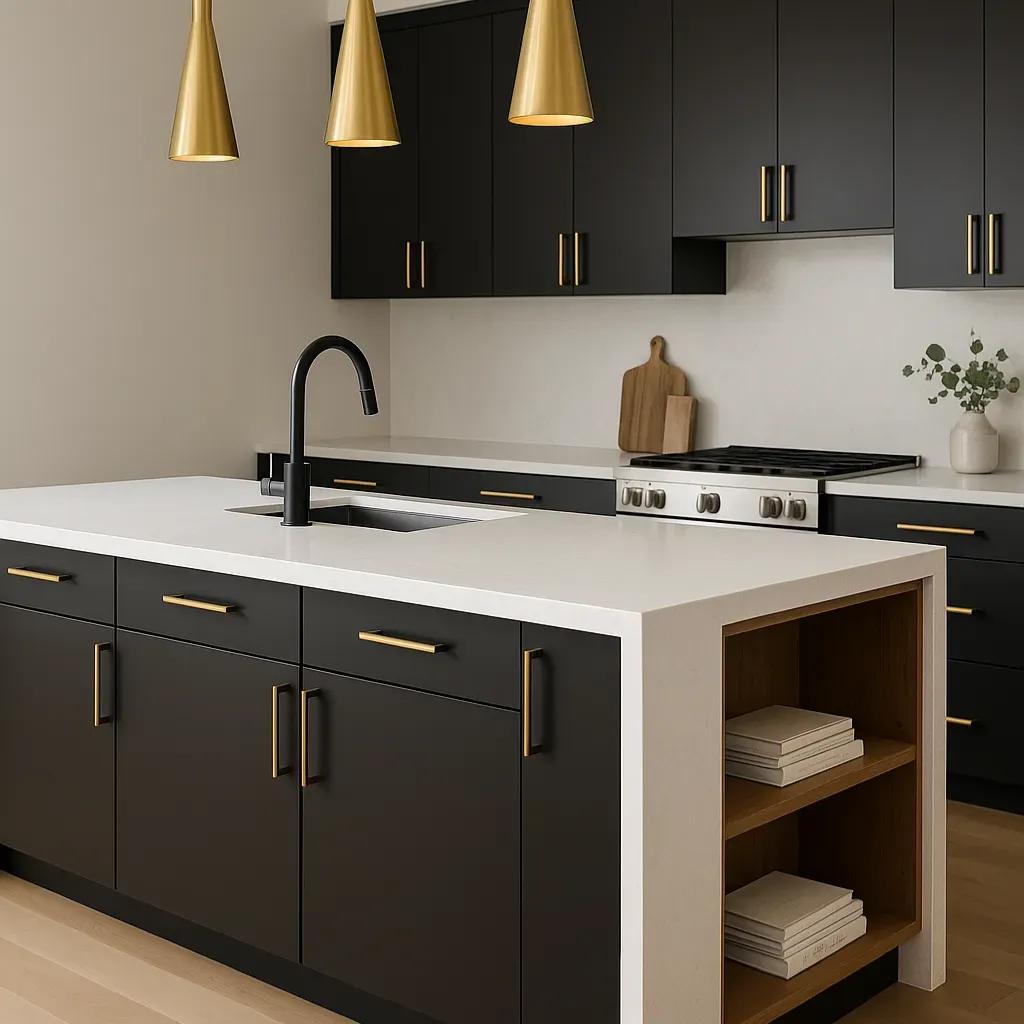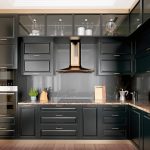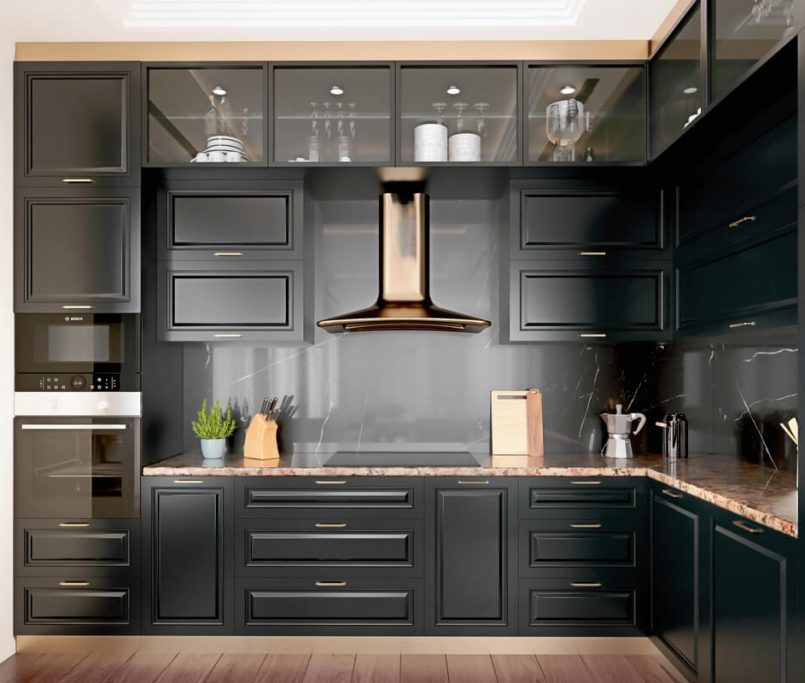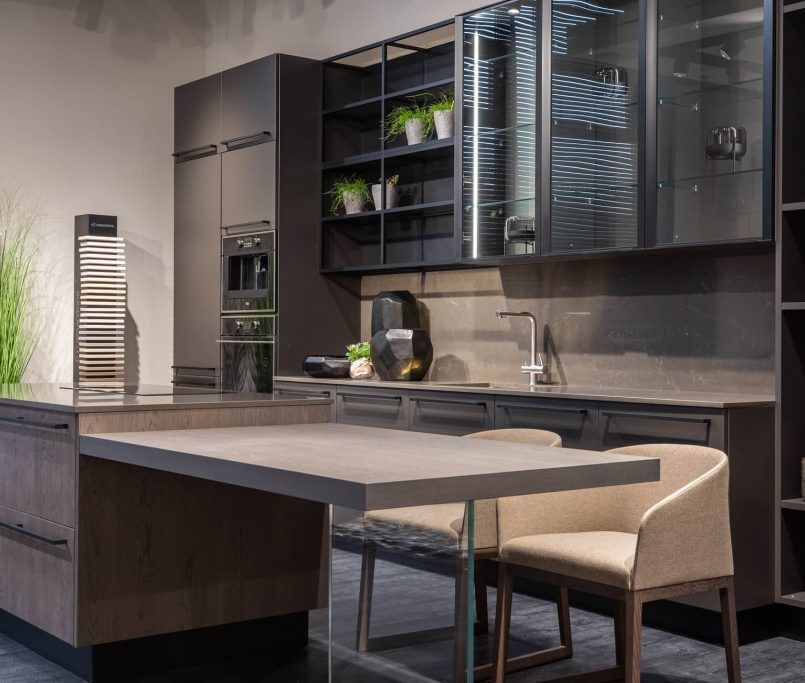Black kitchen cabinets continue their reign as one of the most sought-after design choices for 2026, evolving from a bold statement to a sophisticated, timeless foundation for modern kitchens. Far from being a passing trend, black cabinetry has matured into a versatile design element that works across multiple aesthetics—from contemporary minimalism to farmhouse charm. The key to this enduring appeal lies in how black cabinets are being styled: with matte finishes that add depth, warm metallic accents that provide contrast, and strategic lighting that ensures spaces feel inviting rather than dark.
For Northern Virginia homeowners planning kitchen renovations, black cabinets offer not only stunning visual impact but also practical benefits including easier maintenance and increased home resale value.

10 Key Takeaways About Black Kitchen Cabinet Trends for 2026
- Matte Finishes Dominate: Black cabinets remain a timeless and versatile choice for 2026, with matte finishes dominating over glossy options that can appear dated.
- Warm Metallic Hardware: Brushed brass, champagne gold, and unlacquered brass hardware pairs exceptionally with black cabinetry, replacing cooler chrome and nickel finishes.
- High-Contrast Countertops: Black cabinets paired with white marble or quartz countertops create striking, high-contrast designs that appeal to modern sensibilities.
- Two-Tone Designs: Two-tone kitchen designs featuring black lower cabinets with lighter upper cabinets continue to be popular for adding depth and visual interest.
- Natural Wood Accents: Natural wood accents and flooring complement black cabinetry beautifully, adding warmth to prevent spaces from feeling too dark.
- Increased Resale Value: Black kitchen cabinets can increase home resale value and appeal to buyers seeking modern, high-end aesthetics, with homes potentially selling for up to $6,000 more.
- Seamless Design: Handleless and seamless cabinet designs with integrated pulls or push-to-open mechanisms enhance the contemporary look.
- Mixed Materials: Mixed materials including wood, marble, and metal alongside black cabinets create sophisticated, layered kitchen designs.
- Strategic Lighting: Proper lighting is essential—statement pendant fixtures and under-cabinet lighting ensure black kitchens feel bright and welcoming.
- Low Maintenance: Black cabinets require minimal maintenance with weekly cleaning using mild soap and water, and they hide wear better than lighter finishes.
The Rise of Sophisticated Matte Black Finishes
The texture and finish of black kitchen cabinets have undergone a significant transformation as designers and homeowners move decisively away from high-gloss surfaces toward sophisticated matte finishes. This shift represents more than aesthetic preference—it reflects a deeper understanding of how materials interact with light and daily kitchen life. Matte black cabinets possess a velvety, tactile quality that creates visual depth throughout the day as natural and artificial lighting shifts across their surfaces.
Unlike their glossy predecessors, matte finishes offer practical advantages that make them ideal for busy kitchens. They naturally hide fingerprints, water spots, and minor scratches that would be glaringly obvious on glossy surfaces, reducing the constant need for cleaning and touch-ups. This durability makes matte black cabinets particularly appealing to families and active households. The finish also provides a more refined, contemporary appearance that feels current without being trendy, ensuring the kitchen will remain stylish for years to come.

Design professionals note that matte black works across virtually all kitchen styles, from ultra-modern minimalist spaces to transitional farmhouse kitchens. The finish’s versatility allows it to serve as either a dramatic focal point or a sophisticated neutral backdrop, depending on how other design elements are layered into the space. For Northern Virginia homeowners considering black cabinets, choosing matte over glossy finishes represents an investment in both timeless style and practical functionality.
Warm Metallic Hardware: The Perfect Complement
The hardware selected for black kitchen cabinets plays a crucial role in defining the overall aesthetic, and 2026 sees a decisive shift toward warm metallic finishes that add richness and luxury. Brushed brass, champagne gold, satin brass, and unlacquered brass have emerged as the top choices, replacing the cooler chrome and nickel finishes that dominated previous years. These warm tones create beautiful contrast against black cabinetry while adding a sense of depth and sophistication that cooler metals cannot achieve.
Unlacquered brass deserves special attention among these options because it develops a natural patina over time, creating a living finish that adds character and uniqueness to the kitchen. This aging process appeals to homeowners who appreciate authenticity and the beauty of materials that evolve with use. Brushed brass and champagne gold offer similar warmth without the patina development, providing a consistent appearance that many homeowners prefer. The key is selecting hardware substantial enough to make a visual impact—larger pulls, oversized knobs, and statement handles work better than minimal hardware when paired with dark cabinetry.
Beyond cabinet hardware, extending warm metallic finishes to faucets, lighting fixtures, and even appliance handles creates a cohesive, high-end appearance throughout the kitchen. This coordination demonstrates attention to detail and design sophistication that elevates the entire space. For those seeking a more modern, monochromatic look, matte black hardware can also work effectively, though the warmth of brass and gold tends to feel more inviting and less stark.
High-Contrast Design: Black Cabinets with White Countertops
One of the most enduringly popular combinations in kitchen design pairs black cabinets with white or light-colored countertops, creating high-contrast spaces that feel both dramatic and timeless. This pairing works so effectively because it provides visual balance—the dark cabinetry grounds the space while light countertops reflect light and prevent the kitchen from feeling heavy or closed-in. The contrast also creates clear visual separation between work surfaces and storage, making the kitchen feel more organized and intentional.
White marble remains the premium choice for countertops in black kitchens, with Carrara marble offering subtle gray veining at accessible price points and Calacatta marble providing bolder, more dramatic patterns for luxury projects. The natural veining in marble adds visual interest and organic movement that complements the strong geometric lines of cabinetry. For homeowners seeking lower-maintenance alternatives, white quartz and quartzite provide similar aesthetics with superior stain and scratch resistance.

The backsplash selection becomes particularly important in high-contrast black and white kitchens. White subway tiles offer a classic, fail-safe option that works in virtually any style kitchen. For more visual interest, white or gray marble slab backsplashes create a seamless, luxurious appearance, while geometric or herringbone-patterned tiles add texture without competing with the cabinetry. The key is ensuring the backsplash enhances rather than overwhelms the black-and-white foundation, allowing these primary elements to remain the focal points.
Two-Tone Cabinet Designs: Adding Depth and Dimension
Two-tone kitchen cabinets represent one of the most effective strategies for incorporating black into kitchen design while maintaining visual balance and preventing spaces from feeling too dark. This approach, sometimes called “tuxedo kitchen” design, typically features black lower cabinets paired with lighter upper cabinets, though numerous creative variations have emerged for 2026. The technique adds architectural depth and allows homeowners to embrace dark cabinetry while keeping upper portions of the kitchen light and airy.
The most popular two-tone combinations include black lower cabinets with white or cream upper cabinets, which creates maximum contrast and visual impact. Another trending approach features black perimeter cabinets with a natural wood island, which introduces warmth and textural variety while maintaining the sophistication of black cabinetry. More adventurous homeowners are experimenting with black upper cabinets paired with warm walnut or caramel-stained lowers, which reverses traditional expectations and creates a surprisingly elegant effect.
The strategic advantage of two-tone designs extends beyond aesthetics to practical considerations. Dark lower cabinets hide inevitable wear and scuff marks in high-traffic areas, while lighter upper cabinets reflect light from windows and overhead fixtures, keeping the space bright. This functional aspect makes two-tone designs particularly sensible for families with children or busy households. For Northern Virginia homes with open-concept layouts, two-tone kitchens can help define the cooking space while maintaining visual connection to adjacent living areas.
Natural Materials and Wood Accents: Warming Black Kitchens
The pairing of black cabinets with natural wood elements represents a crucial strategy for creating inviting, livable kitchens that feel sophisticated rather than cold or austere. Wood introduces warmth, texture, and organic variation that softens the strong geometric presence of black cabinetry. This combination has become so popular because it balances the modern edge of black with timeless natural materials, creating spaces that feel both current and enduring.
Light to medium-tone hardwood flooring provides one of the most effective ways to warm black kitchens. Natural oak, maple, and lighter walnut tones complement black cabinets beautifully while reflecting light and making spaces feel larger. The grain patterns in natural wood add visual interest at floor level without competing with upper design elements. For homeowners concerned about maintenance, luxury vinyl plank flooring in wood tones offers similar aesthetics with superior durability and water resistance.

Wood can be incorporated beyond flooring through floating shelves, butcher block islands, wood-beam ceiling details, and even wood-accented range hoods. These elements introduce varied textures and break up expanses of black cabinetry with organic warmth. Open wood shelving mixed with closed black cabinets creates particularly effective contrast, though this approach requires commitment to maintaining styled, organized display areas. For those seeking maximum impact, combining black cabinets with a wood waterfall countertop on the island creates a stunning focal point that showcases both materials at their best.
Black Cabinets and Resale Value: A Smart Investment
For homeowners concerned about return on investment, black kitchen cabinets represent a surprisingly smart choice that can actually enhance home value and marketability. Research indicates that homes featuring black cabinetry—particularly in tuxedo-style configurations—can sell for approximately $6,000 more than comparable homes without this feature. This premium reflects growing buyer preference for modern, distinctive kitchens that stand out from standard white or wood cabinetry.
The resale advantage of black cabinets stems from several factors. First, they signal a recently updated, design-conscious kitchen rather than builder-grade standard finishes. Potential buyers recognize that homeowners who invest in black cabinetry have likely paid attention to other design details and material quality throughout the renovation. Second, black cabinets photograph exceptionally well in listing photos, creating memorable first impressions that generate showing interest. Third, the timeless quality of well-executed black kitchens appeals to a broad demographic, from young professionals to empty nesters seeking modern aesthetics.
To maximize resale benefits, black cabinets should be balanced with lighter elements—white or light stone countertops, adequate lighting, and thoughtful hardware selections. Matte finishes prove more appealing to buyers than dated glossy options, and pairing black cabinets with warm brass or gold hardware adds luxury that justifies premium pricing. For Northern Virginia homeowners planning to sell within five to ten years, black kitchen cabinets represent a renovation choice that combines personal enjoyment with sound financial strategy, particularly in competitive markets where distinctive properties command attention.
Seamless and Handleless Cabinet Design
The move toward minimalist, seamless cabinetry represents one of the most significant design evolutions in modern black kitchens. Handleless cabinets featuring integrated pulls, push-to-open mechanisms, or recessed grip channels create continuous, architectural surfaces that emphasize clean lines and uninterrupted visual flow. This approach feels particularly appropriate for black cabinetry because it allows the material itself—rather than hardware—to become the primary design statement.
Flat-panel black cabinets with integrated handles dominate this trend, providing a contemporary aesthetic that feels both sophisticated and functional. Push-to-open systems eliminate hardware entirely, creating perfectly smooth cabinet fronts that achieve museum-quality minimalism. These systems work particularly well in modern and contemporary kitchen styles where simplicity and geometric purity take precedence. The technology has matured significantly in recent years, with reliable soft-close mechanisms that function smoothly even after years of use.
For homeowners who prefer some tactile element, recessed horizontal or vertical pulls routed directly into cabinet doors offer a middle ground between completely handleless design and traditional hardware. These integrated pulls maintain clean lines while providing obvious grip points that feel intuitive to use. The seamless approach also offers practical advantages beyond aesthetics—smooth cabinet fronts are easier to clean, eliminate hardware that can catch clothing or dish towels, and create a more child-friendly kitchen environment. When combined with matte black finishes, handleless design creates striking architectural presence that defines contemporary luxury.

Mixed Materials: Creating Sophisticated Layers
The most compelling black kitchens for 2026 embrace material mixing as a core design strategy, layering varied textures and finishes to create spaces with visual depth and tactile richness. This approach moves beyond simple color coordination to consider how different materials—wood, stone, metal, glass, and innovative composites—interact to create sophisticated, nuanced environments. The technique prevents black kitchens from feeling flat or one-dimensional while showcasing design expertise through thoughtful material selection.
Stone countertops provide the most obvious opportunity for material contrast, with white marble, quartzite, and quartz offering clean counterpoints to black cabinetry. More adventurous homeowners are exploring dramatic options like lava stone, which provides natural black coloration with organic texture, or soapstone, which develops a soft patina over time. Mixed countertop materials—such as wood on one section of an island with stone on the main work surface—create functional zoning while adding visual interest through material transition.
Glass-front upper cabinets mixed with solid black lowers provide another effective material pairing that adds transparency and display opportunity while maintaining the sophisticated presence of black cabinetry. Metal finishes beyond hardware—including stainless steel appliances, brass light fixtures, and copper cookware—introduce reflective surfaces that catch light and add warmth. Textured backsplash materials such as limestone, basket-weave tile, or fluted marble provide tactile variation behind smooth cabinet surfaces. The key to successful material mixing lies in maintaining a clear dominant element (the black cabinetry) while introducing supporting materials that complement rather than compete.
Strategic Lighting: Brightening Black Kitchens
Proper lighting design becomes absolutely essential in black kitchens, where thoughtful illumination prevents spaces from feeling dark or oppressive while highlighting the sophisticated qualities of dark cabinetry. A layered lighting approach incorporating natural light, ambient lighting, task lighting, and accent lighting ensures black kitchens feel welcoming and functional throughout the day and evening. This strategic thinking transforms potential darkness into dramatic, well-lit spaces that showcase black cabinets at their best.
Statement pendant lights suspended above islands serve both functional and aesthetic purposes in black kitchens. Oversized fixtures in matte black create monochromatic drama, while brass, gold, or copper pendants introduce warm metallic accents that complement hardware selections. Linear pendants work particularly well over long islands, providing even illumination across work surfaces while adding contemporary sculptural presence. The scale of these fixtures should be generous—undersized pendants disappear against dark cabinetry and fail to provide adequate task lighting.
Under-cabinet lighting proves crucial for illuminating countertop work surfaces and preventing shadows in food preparation areas. LED strip lighting provides energy-efficient, even illumination that makes meal preparation safer and more pleasant. This lighting also creates ambient glow during evening hours, adding warmth without requiring overhead fixtures. Natural light through windows and skylights remains the most valuable lighting source, preventing black kitchens from feeling enclosed. For spaces lacking abundant natural light, consider glass-front cabinets on upper levels, which reduce visual mass while allowing light to penetrate deeper into the room. Combining these lighting layers creates black kitchens that feel bright, inviting, and carefully considered.
Modern kitchen with matte black shaker cabinets and white marble countertop island, showcasing a sleek and stylish design.

Maintenance and Care: Keeping Black Cabinets Beautiful
Contrary to common concerns, black kitchen cabinets actually require less intensive maintenance than their white or light-colored counterparts, particularly when finished in matte surfaces that naturally hide fingerprints and minor wear. Understanding proper cleaning techniques ensures black cabinets maintain their sophisticated appearance for years without excessive effort or specialized products. Weekly maintenance combined with periodic deep cleaning keeps black cabinetry looking showroom-fresh with minimal time investment.
For regular weekly cleaning, a simple solution of mild dish soap and warm water applied with a soft microfiber cloth effectively removes fingerprints, cooking splatter, and general kitchen grime. The key technique involves wiping in the direction of any wood grain patterns (on wood-based cabinets) and immediately drying surfaces with a clean cloth to prevent water spots or streaks. Avoid harsh chemical cleaners, abrasive scrubbing pads, or excessive water, all of which can damage cabinet finishes over time. For stubborn grease buildup near cooking areas, a paste of baking soda and water left on surfaces for five to ten minutes before wiping provides gentle yet effective cleaning.
Monthly deep cleaning addresses accumulated grease and maintains the protective finish on cabinet surfaces. A solution of 70% water, 30% white vinegar, and a small amount of dish soap works well for this more thorough cleaning, cutting through grease without harsh chemicals. For matte black finishes, avoid any products claiming to add shine, as these will alter the desired matte appearance. Steam cleaning offers an alternative approach that sanitizes surfaces while loosening stubborn residue, though care must be taken not to oversaturate wood-based cabinets. With consistent basic maintenance, black kitchen cabinets actually hide the inevitable wear of daily use better than lighter finishes, maintaining their appearance longer with less visible aging.
Designing Your Black Kitchen for Northern Virginia Homes
Northern Virginia homeowners planning black kitchen renovations should consider regional factors that influence design success and long-term satisfaction. The area’s housing stock ranges from historic Colonial-style homes to contemporary new construction, each presenting unique opportunities and constraints for incorporating black cabinetry. Understanding how black kitchens function within specific architectural contexts ensures renovations enhance rather than clash with existing home character.
For traditional Colonial, Federal, or Victorian homes common throughout Fairfax, Arlington, and Alexandria, black cabinets work beautifully when balanced with classic elements like marble countertops, traditional backsplash patterns, and period-appropriate lighting fixtures. The key is avoiding ultra-modern minimalist cabinetry that would feel out of place; instead, opt for black Shaker-style cabinets with visible frame details that honor traditional craftsmanship while introducing contemporary color. Brass hardware in traditional styles bridges historical aesthetics with current trends.
Contemporary and transitional homes in Reston, Herndon, or newer Fairfax developments provide more flexibility for modern black cabinet expressions, including flat-panel handleless designs, dramatic material mixing, and bold lighting statements. The region’s strong real estate market means well-executed black kitchens can command premium pricing and shorter time-on-market. Northern Virginia’s proximity to Washington, D.C., brings design-conscious buyers who appreciate distinctive, high-end finishes. Working with experienced local kitchen designers familiar with regional preferences ensures black cabinetry choices align with market expectations while reflecting personal style.
Conclusion
Black kitchen cabinets have transcended trend status to become a timeless, sophisticated choice for 2026 and beyond. The evolution toward matte finishes, warm metallic hardware, and strategic material mixing has refined black cabinetry into a versatile design foundation that works across architectural styles and personal aesthetics. For Northern Virginia homeowners, black kitchens offer the dual benefits of stunning visual impact and increased home value, particularly when balanced with light countertops, abundant lighting, and thoughtful design details.
The key to successful black kitchen design lies in understanding how to layer complementary elements—white marble countertops that create contrast, brass hardware that adds warmth, natural wood that introduces organic texture, and strategic lighting that ensures spaces feel bright and welcoming. Whether pursuing a complete renovation or updating existing cabinetry with black paint, homeowners who embrace these principles create kitchens that feel both current and enduring, combining the best of contemporary design with timeless appeal.
Black Kitchen Cabinet Trends for 2026 Frequently Asked Questions
Are black kitchen cabinets still in style for 2026?
Yes, black kitchen cabinets remain highly popular in 2026 and have evolved beyond trendy to become a timeless design choice, especially in matte finishes. Black cabinets offer remarkable versatility, working beautifully in modern, traditional, farmhouse, and transitional kitchen styles. Their enduring appeal stems from their ability to serve as either a dramatic focal point or a sophisticated neutral backdrop depending on how other design elements are layered into the space.
What countertop colors work best with black kitchen cabinets?
White marble and quartz countertops are the most popular choices, creating stunning high-contrast designs that balance dark cabinetry with light, reflective work surfaces. Other excellent options include light gray quartz, creamy beige stone, and white quartzite. For homeowners seeking a bolder, more dramatic look, black soapstone or dramatically veined marble can create sophisticated monochromatic spaces, though these require more careful lighting consideration.
Do black kitchen cabinets make a space feel smaller or darker?
Not when designed properly with adequate lighting and balanced elements. Natural light through windows and skylights, statement pendant fixtures over islands, and under-cabinet task lighting work together to ensure black kitchens feel bright and welcoming. Pairing black cabinets with white or light-colored countertops, reflective backsplash materials like marble or glass tile, and light wood flooring helps maintain an open, airy feel. Strategic use of glass-front upper cabinets can also reduce visual weight while allowing light penetration.
Modern kitchen with matte black shaker cabinets and white marble countertop island, showcasing a sleek and stylish design
What hardware finishes complement black kitchen cabinets?
Warm metallic finishes are strongly trending in 2026, with brushed brass, champagne gold, unlacquered brass (which develops a patina), and satin brass emerging as top choices. These warm tones add luxury and visual interest against black cabinetry while feeling inviting rather than cold. The hardware should be substantial enough to make visual impact—larger pulls, oversized knobs, and statement handles work better than minimal hardware with dark cabinetry. For those seeking an ultra-modern, monochromatic look, matte black hardware can also work effectively.
How do I maintain and clean black kitchen cabinets?
Black cabinets are relatively easy to maintain, especially matte finishes that naturally hide fingerprints and minor wear. For regular weekly cleaning, use a mild soap and warm water solution applied with a soft microfiber cloth, always wiping in the direction of any wood grain and drying thoroughly to prevent streaks. For stubborn grease, a paste of baking soda and water left for five to ten minutes before wiping provides gentle yet effective cleaning. Avoid harsh chemicals, abrasive cleaners, or any products designed to add shine to matte finishes.
Will black kitchen cabinets help or hurt my home’s resale value?
When executed well with quality materials and balanced design, black kitchen cabinets can actually increase your home’s resale value. Studies indicate that homes with black cabinets—particularly in well-designed tuxedo-style configurations—can sell for approximately $6,000 more than comparable homes with standard cabinetry. This premium reflects growing buyer preference for modern, distinctive kitchens that demonstrate design sophistication. The key to maximizing resale benefits lies in balancing black cabinets with lighter countertops, quality hardware, and adequate lighting that appeals to broad buyer demographics.
What backsplash works best with black kitchen cabinets?
White subway tile offers a classic, versatile option that works in virtually any style kitchen, providing clean contrast without overwhelming dark cabinetry. White or gray marble slab backsplashes create luxurious, seamless appearances that pair beautifully with black cabinets. For more visual interest, consider herringbone patterns, geometric tiles, or textured limestone that add dimension without competing with cabinetry. More dramatic options include black backsplash tiles in varying patterns, which create sophisticated monochromatic spaces when paired with lighter countertops.
Should I choose matte or glossy black kitchen cabinets?
Matte black cabinets are strongly favored in 2026 over glossy finishes, which can appear dated. Matte surfaces hide fingerprints and scratches significantly better than glossy options, require less frequent cleaning, and create visual depth that changes beautifully as lighting shifts throughout the day. The velvety, tactile quality of matte finishes provides a more sophisticated, contemporary appearance that feels timeless rather than trendy. For these practical and aesthetic reasons, matte finishes represent the better long-term investment for most homeowners.
Can I mix black cabinets with other cabinet colors?
Absolutely, and two-tone designs are very popular in 2026. Common successful combinations include black lower cabinets with white or cream upper cabinets for maximum contrast, black perimeter cabinets with a natural wood island that introduces warmth, or a black island with lighter perimeter cabinetry that creates a focal point. These combinations add visual depth and dimension while preventing spaces from feeling too heavy or dark. Two-tone approaches also offer practical advantages, with dark lower cabinets hiding inevitable wear in high-traffic areas while lighter uppers reflect light and keep spaces bright.
What flooring works best with black kitchen cabinets?
Light to medium-tone hardwood floors provide warmth and visual balance that complement black cabinets beautifully. Natural oak, maple, or lighter walnut tones reflect light and make spaces feel larger while the grain patterns add organic visual interest. For those seeking lower-maintenance alternatives, luxury vinyl plank flooring in wood tones offers similar aesthetics with superior durability and water resistance. Other effective options include light gray stone tiles or, for a bold vintage-inspired look, black-and-white checkerboard patterns in ceramic or luxury vinyl tile. Avoid very dark flooring, which combined with black cabinets can make spaces feel cave-like rather than sophisticated.
Ready to Transform Your Kitchen with Timeless Black Cabinets?
At Modern Kitchen & Home Solutions, our experienced design team specializes in creating sophisticated, functional kitchens that reflect your personal style while enhancing your home’s value. Serving Northern Virginia families for over a decade from our Sterling location, we understand how to balance bold design choices like black cabinetry with practical considerations that ensure long-term satisfaction.
Proudly serving: Fairfax County – Loudoun County – Arlington – Alexandria – Chantilly – Herndon – Reston – McLean – Vienna – Ashburn – Leesburg – and throughout Northern Virginia, Washington DC, and Maryland.
Contact us today for a complimentary design consultation and discover how black kitchen cabinets can transform your home. Let’s create a kitchen you’ll love for years to come.
📞 Call Now | 💻 Schedule Your Free Consultation | 🏠 Visit Our Sterling Showroom



